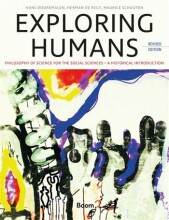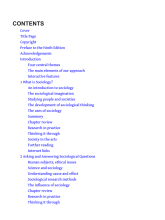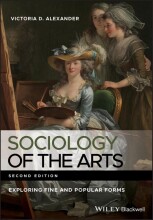Summary: Thinking Art | 9781402056383 | Antoon van den Braembussche
- This + 400k other summaries
- A unique study and practice tool
- Never study anything twice again
- Get the grades you hope for
- 100% sure, 100% understanding
Read the summary and the most important questions on Thinking Art | 9781402056383 | Antoon van den Braembussche
-
2 The Imitation Theory
-
2.1 Introduction
This is a preview. There are 5 more flashcards available for chapter 2.1
Show more cards here -
In Plato's ontology he makes a distinction between the noumenal and phenomenal world.But what do we actually mean with 'Ontlogoy'?
Ontology is abranch ofphilosophy thatdeals with thenature of being,existence and reality.- The word is derived from ancient Greek:
- Ontos (ὄντος ) meaning "being" or "that which is".
- Logica (λογία) meaning "study of" or "science of".
- It
adresses question like: - What kinds of things
exist in theworld ? - What are the basic
categories orstructures of reality? - How do
entities relate to each other within thesecategories ?
-
"Plato's distinction between a noumenal en phenomenal world highlights the distinction between knowledge and opinion."Can you elaborate on this statement?
- Opinions.
- The Phenomenal world is characterised by change and imperfection.
- Therefore, judgements or beliefs based on sensory perception are unreliable and subject to error.
- Plato: such beliefs and judgements are opinions.
- Knowledge.
- The noumenal world is the realm of Forms or Ideas, which are perfect and eternal realities that exist beyond the material world.
- This world represents the true essence/nature of things.
- This world is only accessible through reason and intellect.
- Reason over senses.
- It highlights Plato's belief that true understanding comes from intellectual insight and philosophical reasoning, rather than sensory experience.
-
Can you briefly describe Aristotle's ontology?
- Tabula Rasa: We are born without innate knowledge and gain knowledge through sensory experience.
- Knowledge is born out of interaction between deduction and induction.
- Induction: All observed swans are white, therefore we might induce that all swans are white.
- Deduction: We know the general principle that "all men are mortal" and we observe that "Socrates is a man". Therefore, we can deduce that "Socrates is mortal".
- Tabula Rasa: We are born without innate knowledge and gain knowledge through sensory experience.
-
Can you explain Aristotle's beliefs on Aesthetics?
- Mimesis = fundamental human property.
- Means imitation or representation.
- Creating something that reflects/imitates the reality of the world.
- By imitation we learn about life and we gain joy in life (even if we see tragedy).
- Catharsis: purge emotions in a safe environment, reconcile fear/pity with rational reflection: enlightening.
- Learn to cope with difficult things in life and explore effects of behaviour.
- Mimesis = fundamental human property.
-
Can you explain how the Renaissance's ideal views on beauty is a syncretisation of Aristotelean and Platonic ideas?
- Plotinos (300 CE): Art can be a direct reflection of the world of ideas/forms & Art is a reflection of ideal truth/good/beautiful in an imperfect material world (Plato).
- In Renaissance: emphasis on harmony, unity, symmetry, light.
- Yet also more realistic, with empirical studies on the human body (Aristotle).
-
What are the 2 presuppositions of the modern (philosophical) Realism?
- The phenomenal world is the true world.
- Art can be, and is even necessary to, be an exact copy of that world.
- Depict the ugly truth of our word (don't idealise it).
- The phenomenal world is the true world.
-
3 Expression Theories
-
3.2 Art as the Arousal of Emotion: Leo Tolstoy (1828-1910)
-
In What is Art? , Leo Tolstoy (1828-1910) defended the proposition that art is the "infection" of emotion.Can you explain what Tolstoy meant by this by highlighting Tolstoy's three most important criteria for art?
- Art is about emotion.
- It has nothing to do with knowledge or intellect, but only with emotion and intuition.
- Democratising of arts.
- It's the artist's responsibility to "infect" his audience with the same feelings he himself undergoes.
- This means that the artist must make sure everyone understands these feelings, not only esoteric, highbrow, elites.
- Tolstoy believed art had become a luxury article for the elite and that modern art alienated the masses.
- Art should morally elevate (Ethical).
- Art's mission is to inspire the audience with feelings of brotherly love and solidarity, and to condemn oppression and violence.
- Art is about emotion.
-
3.3 Objections to Tolstoy's Theory
This is a preview. There are 1 more flashcards available for chapter 3.3
Show more cards here -
Leo Tolstoy famously said that Aeschylus, Sophocles, Euripides, Aristophanes, Dante, Tasso, Milton, Shakespeare, Raphael, Michelangelo, Bach, Beethoven are all "artificial reputations called to life by critics" (Tolstoy, 1995, 201-202).This quote perfectly sums up what is deemed the general objection to Tolstoy's vision on art. Can you explain this?
The generalobjection toTolstoy's vision of art is that, if we were to follow his criteria, it wouldlead toarbitrary anduntenable judgements ,requiring us toreject many of the greatestartists who have everwalked theearth . -
3.6 Short Hermeneutic Interlude: The Complexity of Interpretation
This is a preview. There are 1 more flashcards available for chapter 3.6
Show more cards here -
According to Hans-Georg Gadamer, CC-theory is an example of 'traditional' hermeneutics, which has two core errors of reasoning.Can you explain these two errors?
- Traditional hermeneutics implies a clear division between knowledge and reality.
- The knowledge we have is not just a reflection of reality but actually part of reality itself. So, instead of thinking of knowledge and reality as separate, Gadamere sees them as blended.
- Traditional hermeneutics argues that interpretation is independent of the interpreter's individuality.
- Your own experiences, perceptions and reality (horizon of experience) determine how you interpret the sensory information (think of Plato's cave).
- Traditional hermeneutics implies a clear division between knowledge and reality.
-
Can you explain what the 'sophisticated' hermeneutics of Hans-Georg Gadamer is and how it differs from classic hermeutics?
- Hermeneutics of art should be about studying the history of interpretation (Wirkungsgeschichte) of art rather what the art's original intention was (as this is impossible to find)j.
- Differences with classic hermeneutics:
- Hermeneutics is not a method, but a 'way of being' (i.e., we all do it).
- We experience art as something that already has been interpreted.
- Hermeneutics, at best, is a fusion of the horizon of experience of the artist and that of the audience members.
- Hermeneutics of art should be about studying the history of interpretation (Wirkungsgeschichte) of art rather what the art's original intention was (as this is impossible to find)j.
- Higher grades + faster learning
- Never study anything twice
- 100% sure, 100% understanding
































